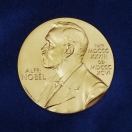Meer weten?

De schimmel Penicillium chrysogenum Thom. (onder) verhindert de groei van de bacterie Bacillus subtilis Ehrenberg (boven). De halo in het midden is de zogenaamde remmingszone. Foto: Science Photo Library. Fotograaf: Wim van Egmond. © ANP/Science Photo Library.
Andere organisaties
Voor de Wetenschapsdag van de KNMP, de beroeps- en brancheorganisatie voor apothekers, maakten Boris Everts en Toine Pieters in 2013 de korte film ‘Resistentie de baas’.
Websites
Het Rijksinstituut voor Volksgezondheid en Milieu (RIVM) publiceerde op haar website een uitgebreid dossier over antibiotica en antibioticaresistentie: https://www.rivm.nl/Overzicht/Antibioticaresistentie.
In 2017 startte het Ministerie van Volksgezondheid, Welzijn en Sport de publiekscampagne ‘Daar wordt iedereen beter van’ met de bijbehorende website https://www.daarwordtiedereenbetervan.nl/.
Literatuur
Deze literatuurlijst is slechts een selectie van wat er de afgelopen decennia verschenen is.
Boeken
- R. Bud, Penicillin. Triumph and tragedy (Oxford: Oxford University Press, 2007)
- M. Burns, The development of penicillin in the Netherlands, 1940-1950: the pivotal role of NV Nederlandsche Gist- en Spiritusfabriek, Delft (proefschrift University of Sheffield, 2005)
- B. Elema, Opkomst, evolutie en betekenis van research gedurende honderd jaren Gistfabriek (Delft: Koninklijke Nederlandsche Gist- en Spiritusfabriek, 1970), p. 34-67
- G.L. Hobby, Penicillin. Meeting the challenge (New Haven en New York: Yale University Press, 1985)
- W.H. Hughes, Alexander Fleming and penicillin (Hove: Priory Press, 1976)
- E. Lax, The mold in Dr. Florey’s coat. The story of the penicillin miracle (New York: Henry Holt & Co., 2004)
- S.B. Levy, The antibiotic paradox. How miracle drugs are destroying the miracle (New York en Londen: Plenum Press, 1992)
- L.J. Ludovici, Fleming, discoverer of penicillin (Bloomington: Indiana University Press, 1955)
- E.H.G. Lutz, Penicillin. Die Geschichte eines Heilmittels und seines Entdeckers Alexander Fleming (Bad Wörishofen: Kindler & Schiermeyer Verlag, 1954)
- G. Macfarlane, Alexander Fleming. The man and the myth (Cambridge: Harvard University Press, 1984)
- J. Malkin, Sir Alexander Fleming. Man of penicillin (Ayr: Alloway, 1981)
- A. Maurois, The life of Sir Alexander Fleming, discoverer of penicillin (Londen: Jonathan Cape, 1959)
- Penicilline... het begin van een nieuwe Nederlandse farmaceutische industrie ([Delft]: Gist-Brocades, 1973)
- J.L. Rodengen, The legend of Pfizer (Fort Lauderdale: Write Stuff Syndicate, Inc., 1999), p. 50-103
- J. Rowland, The penicillin man. The story of Alexander Fleming (Londen: Lutterworth Press, 1957)
- E.M. Tansey en L.A. Reynolds (red.), ‘Post penicillin antibiotics: from acceptance to resistance?’, Wellcome witnesses to twentieth century medicine 6 (Londen: The Wellcome Trust, 2000)
- The discovery and development of penicillin 1928-1945 (Londen: The Alexander Fleming Laboratory Museum, 1999)
- M. Wainwright, Miracle cure. The story of antibiotics (Oxford: Blackwell, 1990)
- D. Wilson, Penicillin in perspective (Londen: Faber & Faber, 1976)
Tijdschriften
- H.A. Bosman-Jelgersma, ‘De Nederlandse farmacie tijdens de Tweede Wereldoorlog’ in: M.J. van Lieburg en W.W. Mijnhardt (red.), Geneeskunde en gezondheidszorg in Nederland, 1940-1945 (Amsterdam en Atlanta: Rodopi, 1992), p. 210-221
- M. Burns en P.W.M. van Dijck, ‘The development of the penicillin production process in Delft, The Netherlands, during World War II under Nazi Occupation’, Advances in applied microbiology 51 (2000), p. 185-200
- F.W. Diggins, ‘The true history of the discovery of penicillin, with refutation of the misinformation in the literature’, British journal of biomedical science 56.2 (1999), p. 83-93
- R. Hare, ‘New light on the history of penicillin’, Medical history 26.1 (1982), p. 1-4
- H.L. Houtzager en M.A. Verschuyl, ‘Delfts pionierswerk: de fabricage en klinische toepassing van penicilline’, Medisch journaal Delft 7.4 (1995), p. 194-198
- G. Shama, ‘Zones of inhibition? The transfer of information relating to penicillin in Europe during World War II’, Advances in applied microbiology 69 (2009), p. 133-159, m.n. 144-148
- J.H. Sypkens Smit, ‘Nederlands pionierswerk in de ontdekking en de fabricage van penicilline’ in: A.H.M. Kerkhoff, A.M. Luyendijk-Elshout en M.J.D. Poulissen (red.), De novis inventis. Essays in the history of medicine in honour of Daniel de Moulin on the occasion of his 65th birthday (Amsterdam en Maarssen: APA-Holland University Press, 1984), p. 453-462
- M. Wainwright en H.T. Swan, ‘C.G. Paine and the earliest surviving clinical records of penicillin therapy’, Medical history, 30 (1986), p. 42-56
- M. Wainwright, ‘The history of the therapeutic use of crude penicillin’, Medical history 31.1 (1987), p. 41-50










